AWeber and Constant Contact are well-established players in the email marketing industry, both offering an array of features. While they have standard functionalities, each platform possesses unique qualities that differentiate them from one another.
So Constant Contact vs AWeber, which tool should you pick?
Constant Contact has been around since 1995, empowering over 600,000 customers to automate their marketing efforts and send beautiful email campaigns.
Similarly, AWeber, which was founded in 1998, actually invented autoresponders, and is renowned for its robust landing page-building capabilities and extensive range of integrations.
How do these established email marketing platforms compare to one another?
In this article, you will gain deeper insights into the functionalities and limitations of each tool. That way, you can make the best choice for your business and grow your email ROI.
Constant Contact vs AWeber: Quick overview
AWeber is a popular email marketing tool, boasting an impressive rating of 4.8 out of 5 in the Shopify App Store. It comes with over 600 email and newsletter templates, which is more than what most tools offer. It also has a pretty generous free plan.
Constant Contact is rated 3.5 out of 5 on the Shopify App Store, which is much lower than AWeber. However, the platform offers an intuitive interface that simplifies processes.
That being said, both tools are quite limited. For example, their reporting and automation capabilities may not meet your expectations. Additionally, AWeber’s user interface isn’t considered very user-friendly.
Another common concern among users is that the pricing plans offered by both platforms don’t correspond well with the features they provide.
Despite these limitations, keep on reading and find out whether Constant Contact or AWeber is better for your business. Along the way, you might discover that there are better email marketing alternatives available for a similar price.
To begin, here’s an overview of the main distinctions between these tools, followed by a comprehensive feature-by-feature comparison of AWeber vs Constant Contact.
Looking at the table, it’s apparent that both tools offer comparable features. However, a closer examination reveals that there are numerous other distinctions between the two.
So, let’s dig deeper into the specifics.
Constant Contact vs AWeber: Feature by feature
Whether you choose Constant Contact or AWeber, your email marketing campaigns will improve.
However, there’s a strong likelihood that one of these tools will provide more incredible benefits for your specific needs. Discover which one is better by exploring further.
Ease of getting started
How easy is it to sign up on both platforms?
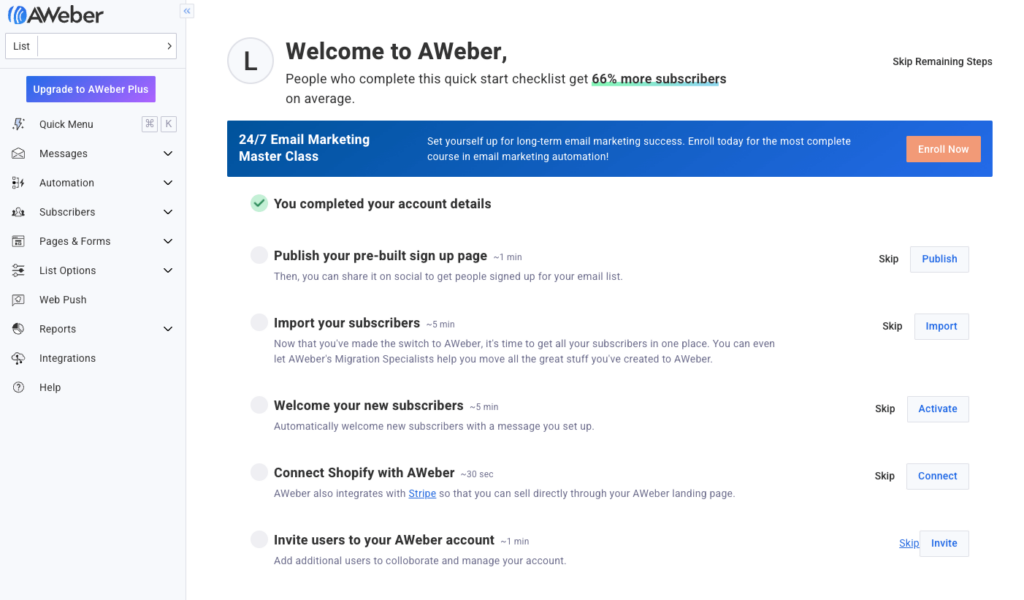
Constant Contact’s free trial and AWeber’s free plan can be used without the need for credit card information. Constant Contact offers a 30-day money-back guarantee, which is unique and something marketers can benefit from.
As for the signup process, it’s quick and easy on both platforms. It demands only the essential information, such as:
- Your name
- Business name
- Email address
- Website URL
To assist users throughout the signup process, Constant Contact provides many tutorials.
However, we found the naming of certain sections in AWeber confusing. For instance, email campaigns are referred to as broadcasts, while automation workflows are called campaigns. This can be somewhat misleading, especially for those new to the platform.
Constant Contact is the winner of this round. Navigating through it is simply much more effortless.
Building an email campaign
Both Constant Contact and AWeber email builders have their own peculiarities that make the email building process different from what we found on Mailchimp, MailerLite, Klaviyo or Omnisend.
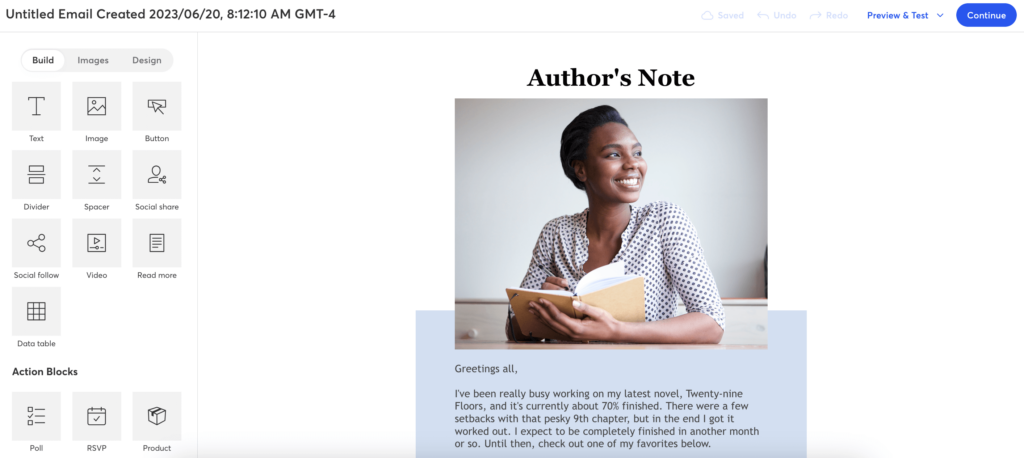
Constant Contact’s email builder is quite intuitive and simplifies creating campaigns. In the email building wizard, there are fewer steps: the campaign name, the subject line and the preheader are placed in the email design step, not as a separate one. This may be a bit unusual, but it’s not a bad thing — it just takes a moment to figure it out.
On the flip side, AWeber’s email builder, called “broadcast builder,” isn’t as smooth and flexible. That being said, you can easily design and customize your emails without coding skills.
This is mainly owing to its extensive library of templates — more than 600. Although some may seem a bit outdated, they fulfill basic email needs pretty well. In addition, AWeber also offers 6,000+ royalty-free images from Unsplash.
Constant Contact indeed presents some intense competition to AWeber on this front. It also boasts an extensive collection of templates for various occasions. The only drawback? The options for editing are limited.
Now, let’s talk about the unique features. With Constant Contact, you can include dynamic links in emails, thus personalizing interaction. On the other hand, AWeber lets users have image carousels in their emails. Moreover, its integration with Canva is pretty helpful.
AWeber also offers product content blocks. But we found it disappointing that you can’t retrieve products directly from the store. Meanwhile, with Constant Contact’s product content blocks, you may experience potential delays in having products displayed.
AWeber and Constant Contact provide basic features to personalize emails and enhance branding. Users can incorporate contact details into subject lines and email content and customize the email design by adding branding elements.
It’s a draw. Both tools have certain limitations but also shine in their unique aspects.
Marketing automation
Next, let’s compare Constant Contact vs AWeber in their automation capabilities.
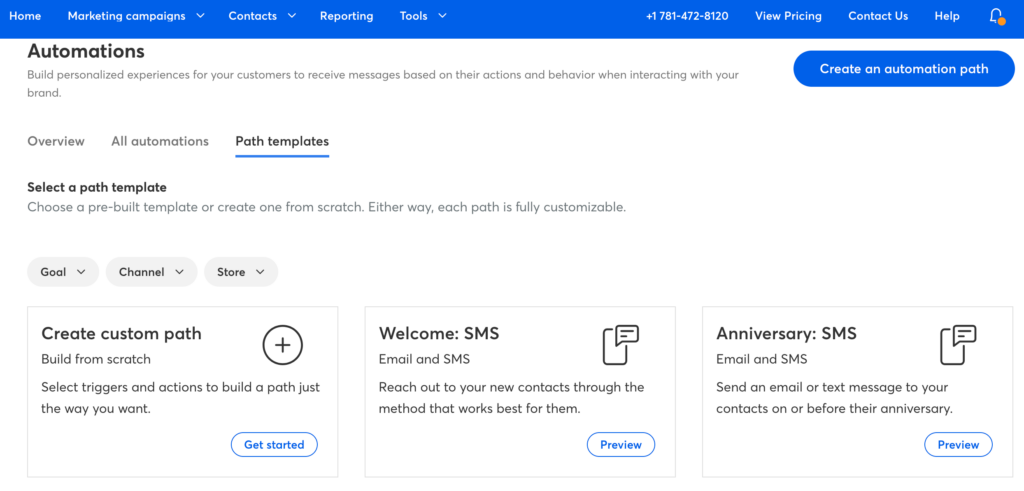
Constant Contact’s interface is clean and straightforward, with standard titles and function names that make it easy to navigate. We noticed that, in contrast, AWeber’s automation builder is a bit clunky.
Constant Contact comes with 15 suggested templates for various scenarios. On AWeber as well, you can find a collection of pre-built workflows for lead magnets, common ecommerce scenarios, blog notifications, welcome series, etc.
However, these can’t be launched out of the box since you must edit the copy yourself. This contrasts with Constant Contact, where templates are logic-ready and have suggested copy.

Overall, we observed that both tools must catch up regarding the number of available triggers, such as website behavior. On AWeber, we also couldn’t find conditional splits and webhooks.
Another thing we found that needed to be added in AWeber was its lack of integrations with other marketing channels. On Constant Contact, it’s possible to integrate SMS into your workflows, albeit at an added cost.
Constant Contact takes the lead in this round since it offers better integrations and logic- and copy-ready templates.
Signup forms and landing pages
Is growing your subscriber list at the top of your priorities? Then go for a tool that excels in signup forms and landing pages.
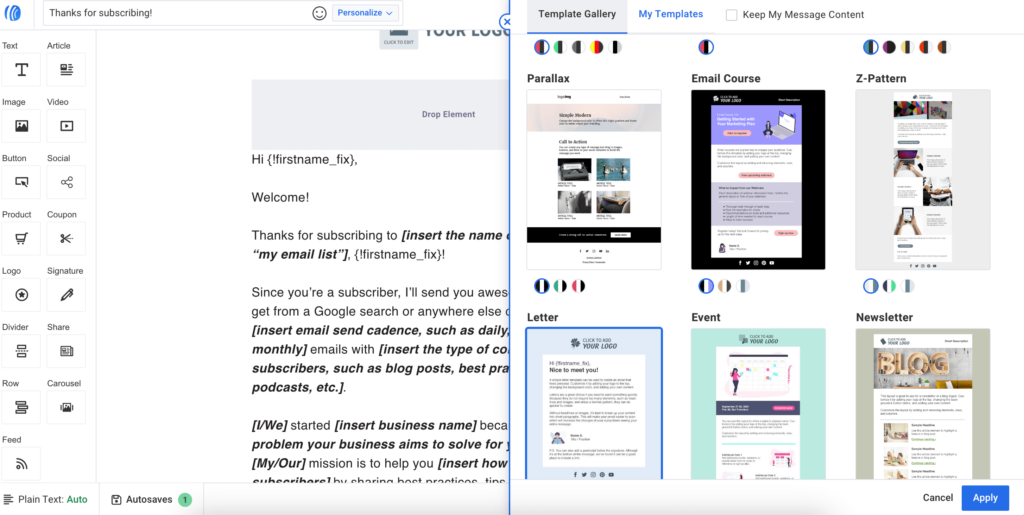
Both platforms offer decent list-building capabilities. But AWeber has a slight edge over Constant Contact. Here are the areas it performs remarkably better in:
- Pre-built signup forms: Although AWeber doesn’t come with any pre-built templates, there are a bunch of layouts for popups. Constant Contact only offers one basic form design you can customize.
- Landing pages: AWeber has a comprehensive landing page builder and many templates. This allows you to create highly engaging landing pages. Constant Contact provides a fundamental landing page builder with no templates.
- Unique features: Constant Contact allows you to create QR codes to direct users to signup forms. But AWeber simply offers a lot more that’s unique. For instance, there’s an option to add popups on top of your full-page signup form, or landing page. In addition, it is possible to add a Buy button and sell directly from the landing page.
In terms of features, AWeber undoubtedly outshines Constant Contact. Unfortunately, the user experience is rather disappointing as the platform feels outdated and sluggish.
As an example, we noticed that it needed to be more straightforward to navigate back to the builder from the “custom fields” page. Additionally, while importing contacts is a straightforward process on both platforms, it tends to be slower on AWeber.
On a positive note, both platforms prioritize compliance with the General Data Protection Regulation (GDPR), ensuring data protection and privacy.
AWeber beats Constant Contact in this round. Despite the slow and outdated interface, AWeber’s features are advanced and distinctive.
Segmentation
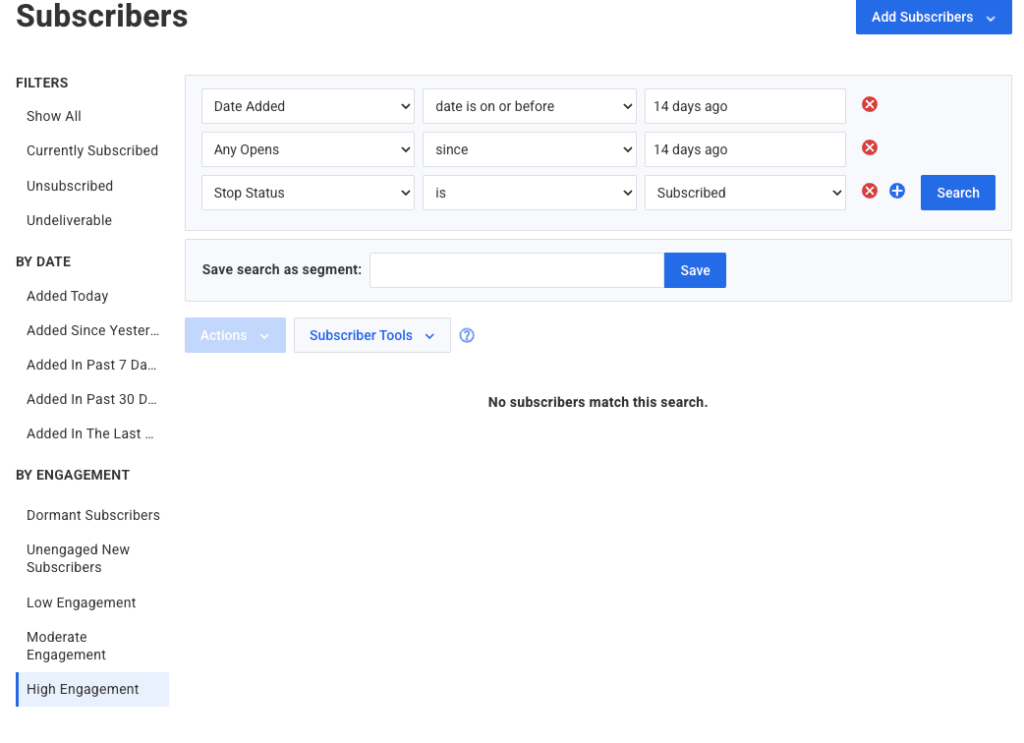
AWeber includes five pre-built segments based on levels of engagement.
- Dormant
- Unengaged new
- Low engagement
- Moderate engagement
- High engagement
Custom segments are available for the higher-tier plans only.
Like AWeber, Constant Contact also offers four pre-built segments based on engagement. However, we noticed a significant difference between the two.
AWeber shows the rules for each segment. Constant Contact doesn’t. Deciphering the exact meaning of each segment is mostly a guessing game.

If you own an ecommerce store, you’d be happy to know that Constant Contact offers specific ecommerce and customer behavior aspects for segmentation. These include:
- Amount spent
- Number of orders
- Email activity
- Memberships
However, the ecommerce features need to be improved compared to other robust platforms like Klaviyo, Omnisend, and ActiveCampaign.
AWeber emerges as the winner because its pre-built segments are clearly defined. It also provides numerous aspects for segmentation, even though it requires a subscription to a high-tier plan.
Analytics
Constant Contact vs AWeber: Which platform offers better analytics?
That’s precisely what we’ll explore in this section, so keep reading to find out.
Constant Contact provides a range of tools to help you analyze the performance of your campaigns. These include:
- Reporting dashboard: It displays open rates, click-through rates, bounce rates, unsubscribe rates, etc. In addition, bar charts make information easy to digest.
- Click-tracking heatmaps: The platform’s high-tier plan comes with email engagement heatmaps. This way, you can identify which areas of your email content attract the most clicks.
- Mobile app: This allows Android and iOS users to access and monitor their email campaign analytics on the go.
AWeber’s suite of reporting tools doesn’t look bad either. With just a click of a button, you can generate reports covering overall data, email open rates, link clicks, etc.
You can conveniently view these metrics collectively for all lists or individually for each specific list. Ecommerce businesses also have the option to view sales over time. For high-tiered plan users, webpage and email sales tracking are available.
Overall, both tools offer basic campaign insights to measure performance. But they lack in-depth predictive insights, especially those valuable for ecommerce businesses.
Before we reveal our verdict, there’s a unique feature of Constant Contact we’d like to highlight. They analyze data from over 200 million emails their customers sent monthly.
This data provides industry benchmarks, helping you gauge how your results compare and strive to surpass your business goals.
Constant Contact has a slight edge here due to its mobile app, heatmaps, and comprehensive dashboard.
Customer support
AWeber’s excellent customer service impressed us. Even free plan users can access 24/7 email and chat support, while paid plan users also benefit from phone support.
Moreover, high-tier plan users receive additional perks like priority support on all channels and free migration assistance.
Users on the Unlimited plan can enjoy dedicated account managers offering personalized assistance and guidance.
Constant Contact is no less, though. Here’s what it offers:
- An award-winning support team
- Comprehensive support options, including phone, live chat, and email
- Onboarding calls for high-tier plan users
However, we found it odd that support is only available on weekdays.
Also worth mentioning is that both platforms offer lots of other learning resources. These include webinars, blog articles, video tutorials, and FAQ sections.
AWeber wins this one simply because it provides support on all days of the week, unlike Constant Contact.
Integrations
Robust integration capabilities eliminate the hassle of switching between multiple platforms.
Constant Contact offers 300+ integrations across various categories such as:
- Ecommerce
- Social media
- Event management
- Analytics
The best part is that you have access to all these integrations regardless of your chosen plan.
Similarly, AWeber offers hundreds of integrations categorized into 12 different categories. Along with the standard categories, they have specialized ones like “webinars” and “productivity tools.”
All these integrations can easily be connected at no cost with just a few simple clicks.
Furthermore, Constant Contact and AWeber provide integration capabilities with Zapier, unlocking many possibilities.
In this round, both tools come out as winners with a comparable number and variety of integrations offered.
Compatibility with other marketing channels
Email marketing isn’t something to be done in isolation. A cohesive and synchronized marketing strategy across multiple channels is crucial.
The only integration AWeber provides is with Facebook Lead Ads. This way, you can easily collect leads from your Facebook advertising campaigns.
Constant Contact may be the ideal option if you’re seeking a broader range of compatibility with various channels. It supports a wide array of media, including:
- SMS (available for US-based users as an add-on)
- Facebook & Google ads
Sadly, neither Constant Contact or AWeber offers support for web push notifications.
Constant Contact wins this round because it’s much more compatible with other marketing channels.
Price Comparison
As we wrap up this Constant Contact vs AWeber comparison, let’s delve into the details of their free and paid plans.
Which software emerges as the more budget-friendly option: Constant Contact or AWeber?
Free plans comparison
While Constant Contact doesn’t offer a free plan, you can explore its features by taking advantage of the 14-day free trial.
AWeber, on the other hand, does come with a free plan. Despite the limitation of 500 contacts, the platform offers a generous allowance of sending up to 3,000 emails monthly.
In terms of the features, here’s what you can expect:
- Email automation
- One landing page
- Signup forms
- Basic segmentation and analytics
- Create and send newsletters
- Library with 1,000+ images
- A few ecommerce-focused features
- Email and chat support
If you want to email more than 500 subscribers monthly, you can pick from one of AWeber’s paid plans.
Paid plans comparison
AWeber provides three pricing plans, including Lite, Plus, and Unlimited.
Constant Contact also provides three pricing plans tailored to suit various use cases. They are:
- Lite: For basic email marketing needs
- Standard: For custom segmentation, advanced automation, and AI
- Premium: For additional features such as ads, SEO, and heatmaps
Here’s a quick Constant Contact vs AWeber pricing comparison:
Whether you choose AWeber or Constant Contact, the cost you pay will primarily depend on the size of your subscriber list. One key difference between the two platforms though is the email sending limit.
Constant Contact provides contact tier allowances of 10x, 12x, or 24x, depending on the subscribed plan. For example, if you have 1,000 subscribers, you would be limited to sending 10,000 emails per month on the Basic plan.
On the other hand, AWeber’s Lite and Plus plans allow you to send unlimited emails. But for enterprises with a huge subscriber base, the Unlimited plan is the most suitable option.
Overall, Constant Contact is pricier than AWeber. Moreover, we found that additional features don’t justify this increased expense. Both tools provide comparable features and excel or fall short in different aspects.
For example, Constant Contact doesn’t have a comprehensive landing page builder, whereas AWeber lacks certain features related to social marketing. Ultimately, your choice should depend on the specific features you prioritize.
Constant Contact vs AWeber: Which one wins?
Before we announce the ultimate winner, let’s summarize the features and pricing of Constant Contact vs AWeber:
4
3.5
500 subscribers – $12
1,000 subscribers – $30
5,000 subscribers – $80
10,000 subscribers – $120
50,000 subscribers – $430
100,000 subscribers – custom price
500 subscribers – $15
1,000 subscribers – $25
5,000 subscribers – $45
10,000 subscribers – $65
50,000 subscribers – $388
100,000 – $788
– Paid plans only
– 14-day free trial
– 3,000 emails per month
– 1 list
– 1 landing page
– 1 email automation
– Email templates
– Easy to get started
– Great customer support
– Great compatibility with other marketing channels
– Strong customer support
– Robust landing page builder and templates
– Lots of integrations
– Basic signup forms and landing pages
– Basic reporting
– Design limitations while building email campaigns
– No free plan
– Not the best user experience
– Includes unsubscribers into your monthly quota
– Price is high but lacks some advanced features
– Ecommerce beginners
– Non-profit organizations
– Corporate organizations that need conservative, stable solutions
– Large ecommerce businesses
– Lifestyle bloggers
– Growing ecommerce business
– Solopreneurs
– Bloggers
– Non-profit organizations
There is no one-size-fits-all solution when it comes to email marketing software.
Speaking of Constant Contact and AWeber, we found that both tools lack the kind of advanced functionalities offered by tools like Mailchimp and Omnisend.
That being said, if you want to send unlimited emails each month, AWeber is an excellent option. It stands out with its exceptional landing page builder and an impressive selection of email templates. It’s just that the overall interface can be a bit clunky, which can slow down your workflow.
On the other hand, if your objective is to integrate additional marketing channels into your workflow, Constant Contact is worth considering. Despite the higher cost, it offers multichannel marketing management from a single platform.
Finally, when it comes to catering to ecommerce needs, both tools fall short. For robust ecommerce-specific features, we recommend considering other email marketing alternatives.
Read full reviews
Our team strives to be accurate and unbiased in reviewing email tools. However, we recognize that mistakes can happen, and it’s essential for us to stay up to date. If you come across any errors or things that need to be reviewed again, please let us know.




Leave a Reply